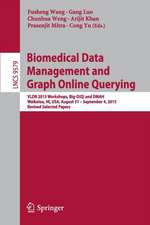Visualizing the Semantic Web: XML-based Internet and Information Visualization
Editat de Vladimir Geroimenko, Chaomei Chenen Limba Engleză Paperback – 31 mar 2011
| Toate formatele și edițiile | Preț | Express |
|---|---|---|
| Paperback (1) | 593.27 lei 39-44 zile | |
| SPRINGER LONDON – 31 mar 2011 | 593.27 lei 39-44 zile | |
| Hardback (1) | 662.80 lei 6-8 săpt. | |
| SPRINGER LONDON – 11 oct 2005 | 662.80 lei 6-8 săpt. |
Preț: 593.27 lei
Preț vechi: 741.59 lei
-20% Nou
Puncte Express: 890
Preț estimativ în valută:
113.53€ • 117.30$ • 94.44£
113.53€ • 117.30$ • 94.44£
Carte tipărită la comandă
Livrare economică 17-22 martie
Preluare comenzi: 021 569.72.76
Specificații
ISBN-13: 9781849969857
ISBN-10: 184996985X
Pagini: 264
Ilustrații: XIV, 248 p. 108 illus., 70 illus. in color.
Dimensiuni: 155 x 235 x 14 mm
Greutate: 0.39 kg
Ediția:Softcover reprint of hardcover 2nd ed. 2006
Editura: SPRINGER LONDON
Colecția Springer
Locul publicării:London, United Kingdom
ISBN-10: 184996985X
Pagini: 264
Ilustrații: XIV, 248 p. 108 illus., 70 illus. in color.
Dimensiuni: 155 x 235 x 14 mm
Greutate: 0.39 kg
Ediția:Softcover reprint of hardcover 2nd ed. 2006
Editura: SPRINGER LONDON
Colecția Springer
Locul publicării:London, United Kingdom
Public țintă
ResearchCuprins
Semantic, Visual, and Technological Facets of the Second-Generation Web.- The Concept and Architecture of the Semantic Web.- Information Visualization and the Semantic Web.- Ontology-Based Information Visualization: Toward Semantic Web Applications.- Topic Maps, RDF Graphs, and Ontologies Visualization.- Web Services: Description, Interfaces, and Ontology.- Recommender Systems for the Web.- SVG and X3D: New XML Technologies for 2D and 3D Visualization.- Visual Techniques and Applications for the Semantic Web.- Using Graphically Represented Ontologies for Searching Content on the Semantic Web.- Adapting Graph Visualization Techniques for the Visualization of RDF Data.- Spring-Embedded Graphs for Semantic Visualization.- Semantic Association Networks: Using Semantic Web Technology to Improve Scholarly Knowledge and Expertise Management.- Interactive Interfaces for Mapping E-Commerce Ontologies.- Back Pain Data Collection Using Scalable Vector Graphics and Geographical Information Systems.- Social Network Analysis on the Semantic Web: Techniques and Challenges for Visualizing FOAF.- Concluding Remarks: Today’s Vision of Envisioning the Semantic Future.
Recenzii
From the reviews of the second edition:
"Extensible Markup Language (XML) is the basis of the semantic Web’s metadata. … The production quality of the book is quite high, featuring high-gloss paper and containing numerous intriguing color screen shots of visualization outputs … . the book does a good job of providing an understanding of the semantic web, presenting its vision and an overview of research into its visualization." (A. E. Salwin, Computing Reviews, December, 2006)
"Extensible Markup Language (XML) is the basis of the semantic Web’s metadata. … The production quality of the book is quite high, featuring high-gloss paper and containing numerous intriguing color screen shots of visualization outputs … . the book does a good job of providing an understanding of the semantic web, presenting its vision and an overview of research into its visualization." (A. E. Salwin, Computing Reviews, December, 2006)
Textul de pe ultima copertă
This pioneering book deals specifically with the visualization of the Second-Generation Web. Now in its second edition it has been completely revised and updated, and includes extensive new material. It focuses on key topics including:
• Visualization of semantic and structural information and metadata in the context of the emerging Semantic Web
• Ontology-based information visualization and the use of graphically represented ontologies
• Semantic visualizations using topic maps and graph techniques
• Web Services, e-commerce and web search applications
• Recommender systems for filtering and recommending on the Semantic Web
• SVG and X3D as new XML-based languages for 2D and 3D visualisations
• Methods used to construct and visualize high quality metadata and ontologies
• Navigating and exploring XML documents using interactive multimedia interfaces
• The use of semantic association networks as well as social networks on the Second-Generation Web
• Semantically enhanced solutions for the medical community
• Semantic-oriented use of existing visualization methods
The design of visual interfaces for e-commerce and information retrieval is currently a challenging area of practical web development. Most of the techniques and methods discussed can be applied now, making this book essential reading for web developers and end users as well as visualisation researchers.
• Visualization of semantic and structural information and metadata in the context of the emerging Semantic Web
• Ontology-based information visualization and the use of graphically represented ontologies
• Semantic visualizations using topic maps and graph techniques
• Web Services, e-commerce and web search applications
• Recommender systems for filtering and recommending on the Semantic Web
• SVG and X3D as new XML-based languages for 2D and 3D visualisations
• Methods used to construct and visualize high quality metadata and ontologies
• Navigating and exploring XML documents using interactive multimedia interfaces
• The use of semantic association networks as well as social networks on the Second-Generation Web
• Semantically enhanced solutions for the medical community
• Semantic-oriented use of existing visualization methods
The design of visual interfaces for e-commerce and information retrieval is currently a challenging area of practical web development. Most of the techniques and methods discussed can be applied now, making this book essential reading for web developers and end users as well as visualisation researchers.
Caracteristici
Still the first pioneering book on the visualization of the Semantic Web New visual interfaces for the Second Generation Internet are investigated and implemented Practical solutions for several important areas of the XML-based internet are proposed Novel metadata-oriented paradigms, metaphors and techniques for information visualization are developed












